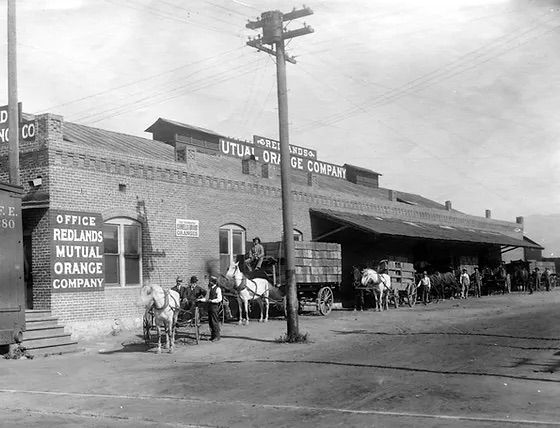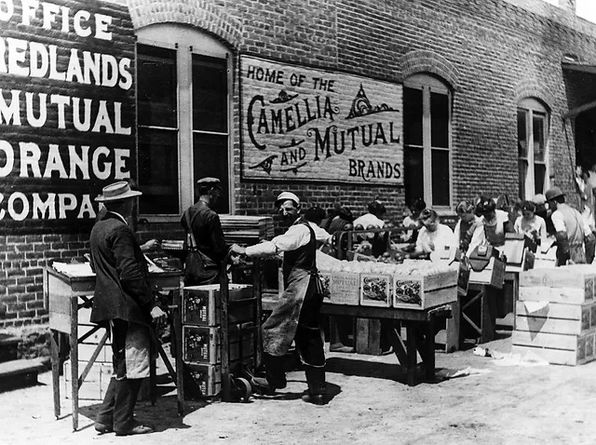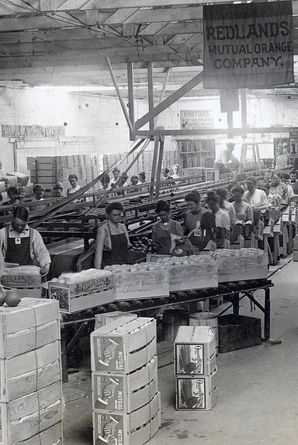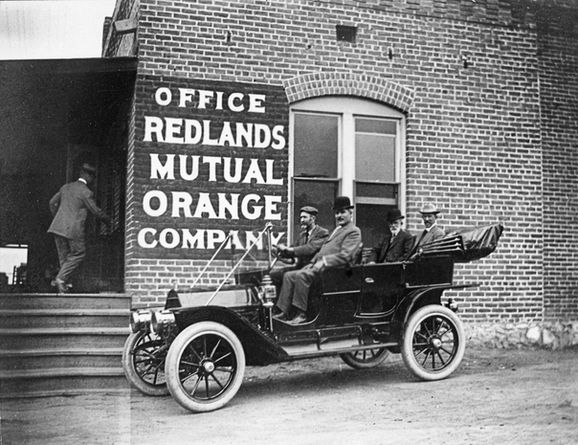


HISTORY
REDLANDS, A MONOLITH OF THE CITRUS BOOM
RPM resides in what was once the Mutual Orange Distributors (MOD) Packing House. A part of Redlands' rich Citrus Industry History, much of that history is still present today in the distinct architecture, scenery, and accents inside and around the building.

Downtown Redlands, one of the epicenters of the navel orange industry, historically and even today has the largest array of citrus-heritage buildings in Southern California. At the Citrus industry’s peak in 1928 there were 14 packing houses in downtown Redlands. Eight have been demolished and the “MOD Packing House” was heading towards the same fate when, following community protest, the City elected to sell the derelict structure for redevelopment.
A small portion of this packing house was originally built in 1894 as Packing House Number 2343214. It was upgraded in 1900 and again in 1906 by the founder Arthur Gregory when it was rebranded and affiliated with Mutual Orange Distributors, an early competitor of Sunkist.
In 1929 MOD reorganized as a non-profit organization, the Redlands Mutual Orange Company, and that year handled about 224,000 packed boxes of citrus fruit and up to four railroad box cars per day along the Southern Pacific rail line (now abandoned on the south side of the building). To accommodate the high demand, in 1930 the sum of $30,000 dollars was spent to upgrade to a new steel truss and corrugated metal roof with north facing clerestory windows, creating the Packing House we see from the inside today.
Our Packing House ceased operations by 1960 and thereafter housed a variety of businesses until it was abandoned in 2000 and finally sold to the City of Redlands in 2006. Arteco Partners was able to purchase the building from the City and after several years of planning and an $11 million dollar renovation from top to bottom (following Secretary of Interior Standards for Historic Rehabilitation) finally reopened Packing House Number 2343214 as Redlands Public Market in February 2025.


THE FREIGHT ELEVATOR
This freight elevator was installed in 1931 and carried crates of navel oranges stored in the cool basement common to packing houses.

THE VAULT
There is a brick office addition, and its built-in safe with 12-inch concrete walls was built in 1908.

THE JUICE-CHUTES
The juice bin and chutes:
Circa 1938. A conveyor belt carried culled oranges up into the wooden “tower” for storing and when full oranges would slide down the two “juice chutes” into the back of a truck to head to the plant to make orange juice.


OLD GROWTH, LOCAL LUMBER

Our salvaged heavy timbers likely date to 1904 – likely harvested in the San Bernardino mountains and provided structural support in the basement of this Packing House.

PUTTING A LABEL ON IT

These are some of the original orange crate labels that we can definitively identify as the brands that were packed in this building by looking closely at archived interior photos dated to the 1900’s.


LEFT THEIR MARK
Near the once open air loading dock for trucks coming from the orange groves. In multiple locations along the once exterior brick wall painted white is the markings of men who worked here- the oldest from 1908.

STANDING STRONG
Some brick walls dates to 1908 when the Packing House was expanded at joined the Mutual Orange Distributors; a competitor to Sunkist. All buildings in downtown Redlands were required by law to be made of brick until the great Long Beach earthquake of 1931, when the decorative brick parapet was removed (or fell during the earthquake), and the exterior brick stuccoed over. A preservation company attempted to remove the stucco to return the building to a brick façade, but it turns out 100 year old stucco sticks a little too good to brick.


AS STRONG AS STEEL
In 1930, $30,000 was spent to upgrade the building from wood to a new steel truss roof with north facing clerestory windows, creating the Packing House we see today. In 2024, 124 tons of steel was added to the structure to seismically retrofit the building to withstand earthquakes.
PRESERVING THE PAST
Rough-sawn 2 x 12 lumber dating to 1904 is the salvaged sub-floor of the Packing House; that took two-men two-weeks to remove all the nails.


ORIGINAL METAL
Original corrugated metal sliding freight doors.

HISTORICAL PHOTO GALLERY











